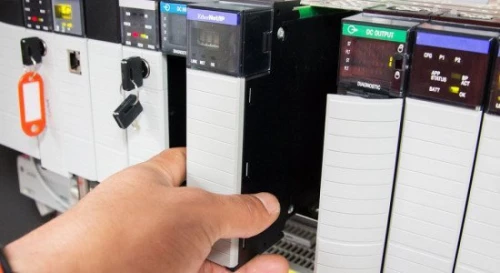Programmable Logic Controllers (PLCs) are the backbone of modern industrial automation systems. Their ability to execute complex control tasks reliably and efficiently makes them indispensable in industries like manufacturing, energy, transportation, and more. This article delves into PLC programming, covering its basics, applications, and best practices for both beginners and seasoned professionals.
What is a PLC?
A Programmable Logic Controller (PLC) is an industrial digital computer designed to control machinery and processes. It monitors inputs, processes logic based on preprogrammed instructions, and drives outputs. Unlike traditional control systems, PLCs are robust, versatile, and capable of operating in challenging environments.
Key components of a PLC include:
- Central Processing Unit (CPU): Executes control programs.
- Input/Output (I/O) Modules: Interfaces for sensors (inputs) and actuators (outputs).
- Power Supply: Provides power to the PLC and its components.
- Programming Device: Used to develop and upload the program into the PLC.
Understanding PLC Programming
PLC programming involves writing instructions that direct the PLC to perform specific tasks. These instructions are typically written in a specialized software environment provided by the PLC manufacturer. Common programming languages for PLCs include:
1. Ladder Logic (LAD)
Ladder Logic is the most widely used language in PLC programming. It resembles electrical relay logic diagrams, making it intuitive for those with an electrical background. The logic is represented as rungs on a ladder, where each rung consists of inputs and outputs.
2. Function Block Diagram (FBD)
FBD uses graphical blocks to represent logical and mathematical operations. It is ideal for implementing control strategies in a visual and structured manner.
3. Structured Text (ST)
ST is a high-level textual language resembling traditional programming languages like Pascal or C. It is suited for complex algorithms and computations.
4. Sequential Function Charts (SFC)
SFC is used to program processes with sequential steps. It visually represents the flow of operations, making it easier to manage multi-step processes.
5. Instruction List (IL)
IL is a low-level textual language that resembles assembly language. While less common today, it offers precise control over the program flow.
Steps to Develop a PLC Program
- Understand the Process:
- Analyze the process to be automated.
- Identify the required inputs (sensors, switches) and outputs (motors, valves).
- Create a Flowchart or Sequence:
- Develop a detailed sequence of operations.
- Break the process into manageable steps.
- Choose the Programming Language:
- Select the appropriate language based on complexity, familiarity, and system requirements.
- Write the Program:
- Develop logic using a PLC programming environment.
- Use comments to document each section of the program.
- Test the Program:
- Simulate the program in the software to identify and fix errors.
- Test the program on the PLC hardware under controlled conditions.
- Deploy and Monitor:
- Upload the program to the PLC.
- Monitor performance and fine-tune the logic as needed.
Applications of PLC Programming
PLC programming finds applications in diverse industries, including:
1. Manufacturing
PLCs control assembly lines, robotic arms, conveyors, and quality inspection systems. They ensure precision, reduce downtime, and enhance productivity.
2. Energy
In power plants and renewable energy systems, PLCs manage turbines, generators, and energy distribution systems.
3. Transportation
PLCs control traffic signals, railway systems, and airport baggage handling systems, ensuring safety and efficiency.
4. Water Treatment
In water and wastewater treatment facilities, PLCs automate pumps, valves, and chemical dosing systems to maintain quality standards.
5. Building Automation
PLCs are used to control HVAC systems, lighting, elevators, and security systems in smart buildings.
Advantages of PLC Programming
- Reliability: Designed to operate in harsh environments with minimal maintenance.
- Flexibility: Easily reprogrammed for new tasks or changes in the process.
- Scalability: Suitable for small-scale to large-scale operations.
- Real-time Operation: Executes tasks with minimal delay.
- Cost-Effective: Reduces labor costs and enhances productivity.
Challenges in PLC Programming
While PLC programming offers numerous benefits, it also comes with challenges:
- Steep Learning Curve: Beginners may find it challenging to master programming languages and industrial processes.
- Debugging Complexity: Identifying and resolving errors in complex programs can be time-consuming.
- Compatibility Issues: Different PLC brands use proprietary software, leading to compatibility challenges.
- Cybersecurity Threats: As PLCs become connected to networks, they are susceptible to cyberattacks.
Best Practices for PLC Programming
- Follow Standards:
- Adhere to international standards like IEC 61131-3 for uniformity and compatibility.
- Modular Programming:
- Break the program into reusable modules to simplify debugging and updates.
- Use Descriptive Comments:
- Document the purpose and functionality of each section for better understanding.
- Simulate Before Deployment:
- Use software simulations to test the program thoroughly.
- Optimize for Performance:
- Minimize scan times by optimizing the logic and avoiding unnecessary loops.
- Ensure Safety:
- Implement fail-safes and error-handling mechanisms to prevent accidents.
- Regularly Update Software:
- Keep the PLC firmware and programming software up to date to ensure compatibility and security.
Future Trends in PLC Programming
As technology evolves, PLC programming is adapting to meet new demands:
- Integration with IoT:
- PLCs are increasingly integrated with the Industrial Internet of Things (IIoT) for remote monitoring and data analysis.
- Advanced Analytics:
- Artificial intelligence and machine learning are being incorporated to optimize processes and predict maintenance needs.
- Wireless Connectivity:
- Wireless PLCs reduce wiring costs and enable flexible installations.
- Open Source Programming:
- Efforts are being made to standardize PLC programming languages and tools to enhance interoperability.
Conclusion
PLC programming is a critical skill in industrial automation, enabling the efficient control of complex processes. Whether you’re a beginner or an experienced professional, understanding the basics, applications, and best practices can significantly enhance your ability to design and implement effective automation solutions. With the advent of new technologies, the scope of PLC programming is expanding, promising exciting opportunities for innovation and growth.
Investing time in mastering PLC programming is not just a technical endeavor but a step toward shaping the future of automation.

